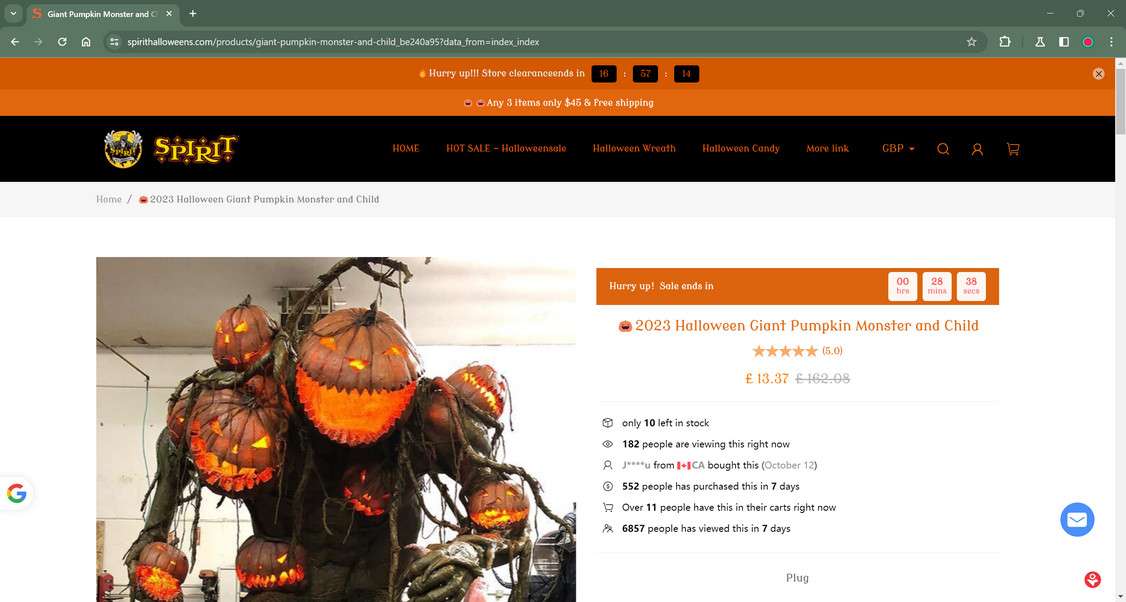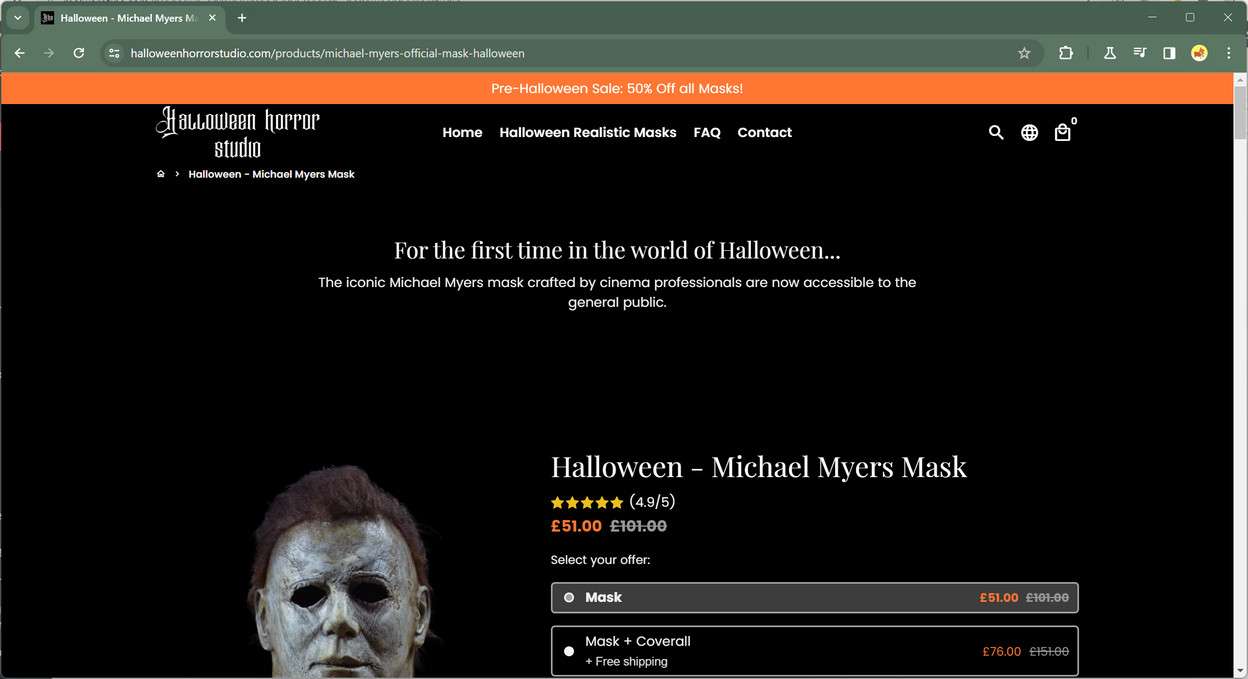Halloween is one of the most popular holidays for online shopping scams. Scammers create elaborate fake Halloween shopping websites to trick people into buying non-existent products or services. These scams have become increasingly sophisticated in order to dupe unsuspecting shoppers. Being able to identify fake Halloween websites can help you avoid falling victim to these online shopping scams.
Overview of the Halloween Shopping Scam
The Halloween shopping scam has become more rampant each year as consumers do more of their holiday shopping online. Scammers recognize the opportunity to create fake Halloween merchandising websites to take advantage of this increase in spending.
Scammers Create Convincing Ecommerce Websites
The scammers invest significant time into making the website look exactly like a real online Halloween store. They choose domain names related to Halloween and web hosting services with no identifiable information. The sites have well-designed layouts, product photos and descriptions, shopping carts, and checkout processes. To seem more legitimate, they also have FAQ pages, shipping details, return policies, and terms of service agreements. An average consumer glancing at the site would not suspect it’s a scam.
Promotions Use Fear of Missing Out
Scammers promote the fake websites heavily on social media platforms like Facebook and Instagram. They pay to run ads featuring some of the Halloween products available on the site. The ads tout “limited time only” huge discounts or flash sales, trying to instill a fear of missing out in consumers. This gets people to urgently click on the links to shop the sales before they are gone.
Irreversible Payment Methods Used
On the checkout page, the scammers only accept forms of payment that are difficult to reverse, like wire transfers, prepaid cards, and cryptocurrency. They specifically avoid options like credit cards that offer buyer protection. This prevents victims from being able to get their money back through their bank or credit card company.
Quick Shutdown After Collecting Payments
Shortly after launching the scam and collecting numerous payments, the scammers take down the website and disappear. They make sure to mask their identity when setting up the domain name and web hosting. This leaves victims with almost no way to track the scammers down to try to recover their money.
By executing each step of this process, scammers are able to rip off consumers to the tune of thousands of dollars in just a short period of time. Their use of social media promotions and convincing ecommerce websites allows them to execute the Halloween shopping scam on a mass scale.
How the Halloween Shopping Scam Works
Scammers rely on a few key strategies to successfully pull off elaborate fake Halloween shopping scams each year:
1. Creating Realistic Ecommerce Websites
The scammers invest a significant amount of time and effort into making the website look exactly like a legitimate online retailer. They choose a domain name containing Halloween-related keywords that will come up in searches for things like “Halloween costumes” and “Halloween decorations”.
The site is designed using professional ecommerce platforms like WooCommerce or Shopify. This gives the site the same look and feel as a real online store, with a polished template, consistent branding, and easy navigation.
The website is filled with hundreds of Halloween-related products like costumes, candy, décor, and party supplies. Each item has a unique photo and thorough description detailing sizes, materials, and other attributes. This level of detail makes the merchandise seem real.
The site has additional ecommerce functionality like shopping carts, customer accounts, order tracking systems, FAQ pages, shipping calculators, and terms of service agreements. All of these elements work together to convince visitors they are at a legitimate retailer’s website.
2. Promoting Scam Sites Through Social Media Ads
Scammers rely heavily on social media advertising to promote their fake Halloween sites. They create business Facebook and Instagram pages for the scam websites and pay to run ads linking to the site.
The ads are carefully crafted around Halloween themes to target those actively searching for or interested in Halloween products online. They feature some of the costumes, decorations, and party supplies available on the site.
Many tout limited-time flash sales or massive discounts only available on the website for a short period. This creates a fear of missing out, causing people to feel urged to visit the site to take advantage of the deal before time runs out.
The scammers often impersonate legitimate brands both in the ads and on the website, making customers think they are shopping with a real, reputable company.
3. Accepting Only Untraceable Payments
A key component of the scam is getting paid in a way that cannot be reversed. On the checkout page, the site will claim they only accept payments like:
- Direct bank wire transfers
- Prepaid gift cards
- Cryptocurrency
- Third-party payment apps like Zelle or CashApp
By avoiding standard options like credit cards or PayPal, it makes it nearly impossible for customers to get their money back. The site will make excuses that these alternative payment methods enable faster processing, better fraud protection, or more secure transactions. But in reality, it just covers the scammer’s tracks once they’ve received the funds.
4. Rapidly Taking Down Websites
Shortly after launching a scam site and collecting as many orders as possible, the scammers remove all traces of the website and disappear. They only keep fake sites up long enough to rip off consumers during a short window of high spending, like Halloween season.
The scammers make sure to mask their identity through domain privacy services when first setting up the site. This makes it extremely difficult for victims to track down who scammed them in order to recover lost funds.
Once the payments are received and the site is taken down, victims have almost no recourse to get their money back. Meanwhile, the scammers walk away with thousands in stolen funds.
How to Identify Fake Halloween Shopping Websites
When searching for Halloween deals online, be vigilant in assessing stores to avoid scam sites set up to steal your money. Here are some telltale signs of fraudulent Halloween shopping websites:
- Domain registered recently – Research new sites on lookup tools like Whois. Scam sites often have domains registered within the past year.
- Generic domain name – Scam sites tend to have broad domain names focused on keywords, not unique business names. Example: halloweenstoreonline.com.
- Mismatched location info – The site may claim to be a U.S. retailer but Whois shows an international address. This mismatch is a red flag.
- Prices that are very low – Extremely cheap prices compared to regular stores are a sign you’re not dealing with a legitimate retailer.
- Limited payment options – Scam sites tend to only take PayPal, wire transfers, gift cards, etc. Avoiding credit cards is a strategy to prevent refunds.
- Poor website quality – Fake sites often have spelling errors, broken links, weird formatting, and place holder text that indicate a hastily made site.
- No customer reviews – Legitimate retailers selling for several years will have customer reviews visible on their site. New sites without them should be approached cautiously.
Scrutinize unknown sites carefully for these scam flags. Dig into the domain details, seller location, prices, payment options, and site quality before entering any sensitive information. Don’t let the promise of an unbelievable deal blind you to an obvious sham site.
How to Spot Halloween Shopping Scams on Facebook
Facebook has become one of the top channels for scammers to promote Halloween shopping scams through paid ads and posts. Here are some signs to look for to identify their Facebook scams:
- Ads promoting suspicious “limited time only” sales – Scam ads will push sales claiming things like “One day only!” or “Today only!” to create urgency. Legitimate brands rarely have temporary blowout sales on Halloween gear.
- Prices that seem too good to be true – Beware ads hawking deeply discounted prices on popular Halloween products. If the deals seem too amazing to be real, they probably are.
- Links going to sketchy websites – Click any website links in the ads and inspect the destination site closely. Look for red flags like misspellings, strange URLs, and template layouts.
- Newly created Facebook pages and websites – Scam pages tend to be recently made with little engagement or followers. Check when the Facebook page was started and look up the site’s domain on Whois.
- Limited or no company information – Scam Facebook pages lack an “About” section with company details. Websites also provide little info and no real address.
- No interaction with commenters – Engage with the Facebook page by asking questions in comments or posts. Scams won’t reply or will give vague automated responses.
With scrutiny, the fraudulent Facebook pages promoting Halloween scams display plenty of warning signs. Avoid making purchases through ads pressuring urgency or deals that seem unrealistic. Do your due diligence in researching unfamiliar sites before providing payment info.
How to Detect Halloween Scams on Instagram
Instagram is filled with fake shopping accounts trying to take advantage of people searching for Halloween costumes, decorations, and party supplies. Here’s how to analyze Instagram sellers to avoid getting scammed:
- No business information – Check the Instagram profile for an actual business location, phone number, or email address. Scammers leave this info out.
- Pushing “Limited Time” deals – Scam accounts tout special discounts and flash sales that create false urgency to buy before you miss out.
- Follower count doesn’t match engagement – Scam accounts often have tons of followers but very few likes/comments on posts. This is a result of bot followers.
- Comments seem fake – If the comments have generic messages like “Thanks!” or “So cool!”, they are likely fake accounts trying to seem legitimate.
- Quick rebranding – An Instagram account that frequently changes its name/bio to adjust to new trends can signal a scammer evading detection.
- No tags on products – Sellers tagging the brands or designers of the products they post is standard practice. No tags is suspicious.
- Shady payment methods – Profiles directing shoppers to sites that only accept PayPal, wire transfers, gift cards, etc. should be avoided.
Do your homework in checking for major red flags on Instagram shopping accounts before you buy. A sense of urgency, fake engagement, and lack of valid details are signs you’re dealing with a scammer, not a real retailer.
Identifying Halloween Shopping Scams on TikTok
TikTok has emerged as a platform scammers leverage to advertise fake Halloween shopping websites, often targeting younger audiences. When shopping from sites promoted on TikTok, be on the lookout for these signs of potential scams:
- Promo codes and links in captions – Videos will include codes for big discounts or links to unknown shopping sites in the captions to entice clicks.
- Comments disabled – Scam TikTok accounts usually disable comments on their promo videos to avoid skeptical users calling them out.
- New accounts with few followers – Check the profile and see how long they’ve been on TikTok. New accounts with almost no followers are big red flags.
- Vague business details – The TikTok account and linked website provide little concrete information about who owns it or where it’s located.
- Stock content – Scam sites featured tend to use stolen product photos and generic descriptions, not original content.
- Pushy sales tactics – Videos emphasize urgency to buy by claiming “flash sales” that expire soon or low stock that’s selling out.
- No actual shopping experience – Videos only showcase products or share promo info, not actual customer experiences shopping on the site.
Approach cheap Halloween products promoted heavily on TikTok with ample skepticism. Vet any websites thoroughly using other sites like Whois and BBB before purchasing. Dig for concrete details on who is behind the business. If it seems fishy, trust your gut and avoid the potential scam risks.
What to Do If You’ve Fallen Victim to a Halloween Shopping Scam
If you unfortunately fell prey to one of these fake Halloween shopping scams, here are the steps you should take right away:
Immediately Contact Your Bank
If you paid with a debit or credit card, call your bank or credit card company’s fraud department right away. Alert them that the online retailer you purchased from was fraudulent. Request that they reverse the charges and refund any stolen funds.
Provide as much detail as possible on the purchase dates, amounts, and merchant names. Also explain that the website has disappeared after taking your payment info. The sooner you report it, the better chance your bank can recover the payments before the scammer deposits them.
Cancel Any Prepaid Cards
If you purchased reloadable gift cards or prepaid cards to pay the scammers, contact the card issuer immediately to cancel it. Ask them to refund any remaining balance that has not been spent yet by the fraudsters. Be sure to keep your card number handy when you call.
Time is of the essence with prepaid cards. You want the issuer to freeze the funds before the scammers can liquidate and spend them. Provide details on the fraudulent website and transaction.
Reset All Passwords
Since you entered your payment information into the fake site, change passwords for those accounts right away. This includes passwords for your online banking, Paypal, credit cards used, and more.
Resetting passwords prevents the scammers from accessing these accounts now that they have your login info. It protects you in case they try other angles like logging in to steal funds or make additional purchases.
Place Fraud Alerts
Contact the major credit bureaus to place fraud alerts on your credit reports. This requires creditors to verify your identity before opening new accounts, which protects you from potential identity theft. The alerts stay on your credit reports for 90 days but can be renewed.
Report Details to the FTC
File an official complaint with the Federal Trade Commission (FTC) about the Halloween shopping scam and website. Provide them with all the site details, product info, payment methods, and promotion techniques used.
Reporting scams helps the FTC track incidents, size up the impact, and build cases against bad actors. The more victims who report, the stronger the case.
Spread Awareness on Social Media
Post on your own social media channels about the Halloween shopping scam to spread awareness. Share actionable details like the website URL, products advertised, and promotion techniques used. The more people informed, the fewer who will fall for the scam.
Also report the scammers’ social media accounts or ads to try and get them taken down. This prevents them from promoting the fake sites to additional victims.
Frequently Asked Questions About Halloween Shopping Scams
How do scammers set up fake Halloween shopping websites?
Scammers register new domains, set up hastily-made ecommerce sites, steal product images and descriptions from other sites, and use web hosting services that protect their identity. The sites are designed to look like legitimate online stores on the surface.
What payment methods do the scam sites accept?
Most only accept forms of payment that cannot be reversed, like direct bank wires, prepaid gift cards, and cryptocurrency. They avoid standard options like credit cards that allow people to dispute charges.
How do they promote the scam sites?
Fake Halloween shopping sites rely heavily on Facebook and Instagram ads to drive traffic. Scammers pay to run targeted seasonal ads touting big discounts and using fear of missing out tactics in the copy.
How soon after launch do they take down sites?
Most scam Halloween shopping sites are only operated for a few weeks before Halloween to capitalize on the surge in consumer spending. Once the holiday passes, scammers take the sites down quickly.
Can I get my money back if I paid by credit card?
If you used a credit card, you can dispute the charges by alerting your credit card company it was a fraudulent transaction. By law, credit cards have protections against scams and will refund your money.
What if I paid through wire transfer?
Unfortunately, wire transfers are nearly impossible to reverse once the money is received by the scammers. Your bank cannot recall the funds unless the account owner voluntarily sends it back.
Should I report the scam website?
Absolutely. Reporting the site to the FTC and social media platforms can help get fraudulent sites taken down. This prevents the scammers from victimizing more people.
How can I identify a fake site next time?
Look for red flags like mismatched location info, recently created domains, prices that seem unrealistic, limited payment options, and suspicious social media promotions directing you there.
The Bottom Line
Halloween shopping scams are prolific online as scammers take advantage of the surge in seasonal spending. They invest heavily in creating fake websites with convincing product catalogs tailored to Halloween themes. Deceptive social media promotions drive traffic and sales for a short window until the sites disappear. By only accepting untraceable payments, victims are left helpless in getting funds returned. If you do get ripped off, act extremely quickly to report it to financial institutions and try to limit damages. Avoiding sketchy sites and being cautious when shopping online helps prevent handing money over to scammers.
Conclusion
This comprehensive guide outlines how elaborate Halloween shopping scams work and what victims should do if they fall prey. Key takeaways are to look for red flags of fake sites, use payment methods with buyer protection, and report fraud attempts immediately. With vigilance and awareness of common tricks, consumers can enjoy holiday online shopping while steering clear of scammers seeking to take advantage. Being an informed shopper remains your best defense against the influx of holiday shopping scams online.














